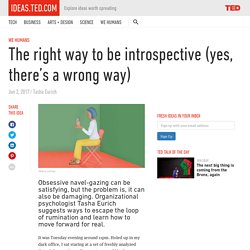

ChooseToBeHappy. 3:Self-Exploration: How therapists resolve core issues. Chapter 2, Part 3: From the book, You Can Choose To Be Happy, Tom G.

Stevens PhDGo to Happy HomepageGo to book contents Go to chapter contents Contents: Some traditional stress-reduction or positive thinking approaches are limited Create your own internal psychologist Fear of the inner monster--Most of us fear looking too far inside Overview of Self-exploration process Step 1: WARM UP YOUR INNER OBSERVER Step 2: FOCUS ON SITUATIONS WHEN THE PROBLEM OCCURS Step 3: FOLLOW THE STRONGEST EMOTIONS to the HEART OF THE PROBLEM. 3:Self-Exploration: How therapists resolve core issues. PTSD: why some techniques for treating it work so fast. Joe Griffin suggests that post-traumatic stress disorder treatments that can yield immediate success share an underlying mechanism, which explains their effect.

A MAN recalls the terrifying moment when the bomb went off that blew away the lower part of his leg. He shakes as, yet again, the images crowd in upon him, the screaming, the smell of burning, the sudden blackness, the splintering glass. He has come to see a therapist because these images and fears, from eight years ago, still continually invade his life. Quickly, the therapist works to calm him down, relaxing him deeply, and then gradually guides him to experience himself going swiftly backwards through the trauma, as if he were a character in a video, which is being rewound.
The therapist then asks him to view the trauma as if in fast forward on a TV screen. Another therapist in another therapy room requests a man to focus on a traumatic memory from the day that he nearly lost his life in an industrial accident. References. PTSD: why some techniques for treating it work so fast. Moodle. Self-reflection is about asking yourself thought-provoking questions so that you can develop a deeper level of understanding yourself.

The biggest value added of self-reflection is that you can change how you see yourself and how you feel about certain situations and, in the end, how you act. New thoughts lead to new emotions and consequently to new actions. Nevertheless, performing self-reflection regularly isn’t easy, especially in the beginning. We are so busy that we often lose touch with ourselves, and all the different distractions and responsibilities prevent us from really listening to our true self. We most often only hear our inner voice when it comes out as a critique of ourselves or others. Starting with self-reflection activities is similar to starting with meditation. Your ideal and ought self There are three basic versions of yourself.
Your first step should be to make a persona (clear character representation) about your actual self, ideal self and ought self. Empathy map. The right way to be introspective (yes, there’s a wrong way) Valery Lemay It was Tuesday evening around 11pm.

Holed up in my dark office, I sat staring at a set of freshly analyzed data. A few weeks earlier, my team and I had run a study looking at the relationship between self-reflection and outcomes like happiness, stress and job satisfaction. I was confident the results would show that people who spent time and energy examining themselves would have a clearer understanding of themselves and that this knowledge would have positive effects throughout their lives.
But to my astonishment, our data told the exact opposite story. We can spend endless amounts of time in self-reflection but emerge with no more self-insight than when we started. Though I didn’t know it at the time, I’d stumbled upon a myth about self-awareness, and one that researchers are only beginning to understand. Why does this matter? Introspection is arguably the most universally hailed path to internal self-awareness. Asking “why?” Do you medicalise your emotions? Learn to stop fixing and start feeling. Written by Marie Rowland ,October 29, 2019 Credit: Toa Heftiba The human condition is unique but not so different from that of other species which also feel a range of emotions, from elation to desolation.

Our evolutionary design meant that we needed to act upon feelings as part of our own self-preservation. After all, it was handy to experience fear when being chased down by a sabre-toothed tiger or to crave tribal belonging so as to not have to fend for yourself in the wilderness. But in the past 50 years survival has come down to diagnosing and labelling rather than acknowledging and accepting the very real sensations that inform us about our human experience. Popping the happiness pill The 19th-century American short-story writer William Sydney Porter, famed for his wit and surprise endings, wrote simply and succinctly about what it is to be human: “Life is made of sobs, sniffles and smiles, with sniffles predominating.” Branding emotion We too have become quick to label.